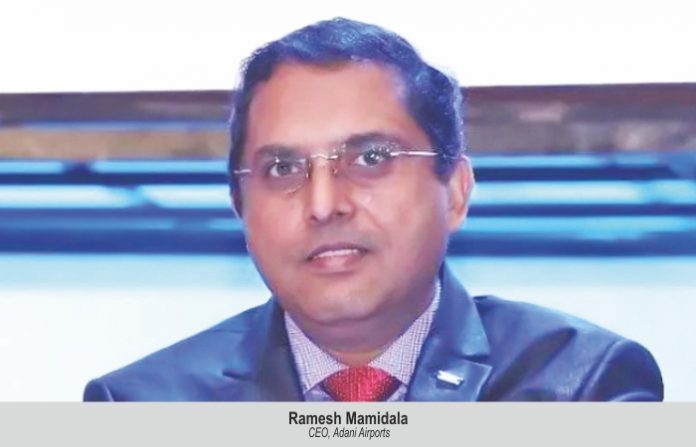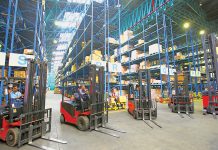Every airport will see huge investment in terms of capacity enhancement. Focus is on developing infrastructure. Now the industry should work towards achieving 10 million tonnes by 2030, says Ramesh Mamidala, CEO, Adani Airports. India must have its own dedicated freighters to utilize capacity fully and embrace 100 per cent digitalisation, he adds.
Ritika Arora Bhola
How are things shaping up for the air cargo industry after COVID cases reduced? Where do you see the growth chart moving ahead?
During the pandemic, we were not sure as to when the industry would recover. The year 2020 was quite hard for the air cargo industry. We had made our own assumptions for different airports across the country. But most airports had started recording growth and recovered early 2022. Some of the airports of the country had in fact recovered pre-pandemic levels and went beyond the pre-pandemic levels. I think the operations did not get disrupted much at the Indian domestic airports.
At the same time, international cargo recovery has been a bit slow for multiple reasons. One of the main reasons is the global policies formed during the pandemic related to the aircraft and charters operations. They were not fully operational. Also, European regions, and Middle East have still not completely recovered. They have not gone back to the earlier schedules, resulting 70-80 per cent capacity loss.
During COVID, we saw the emergence of converted freighters, which assisted in movement of goods, especially pharmaceuticals and perishables across the world. But there have been a lot of constraints—under-utilized capacity, unskilled manpower and inadequate infrastructure.
Some small airports across the world are still suffering because of a lack of better freighter capacity, lack of full recovery of global tax operations and change of aircraft from white body to narrowbody. Levy of GST on exports announced by the government from 1 October also impacted perishable business even further. In the middle of this, the long-term prospect of air cargo is still positive. Personally, I am quite bullish about growth of air cargo. With the kind of developments taking place, we will be able to achieve the 10-million target set by the government by 2030. and we should focus on it now.
What are the crucial areas of concern?
I feel few policy changes are required from the private sector as well as government. The air cargo associations have been lobbying for those policy changes and if the policy adjustments happen, our own Indian carriers will recover and bring back capacity back to the market. Freight rates fortunately are adjusting to the right side. Infrastructural development is also happening across major airports, but there is scope for more. There has been integration of IT Systems, such as ACCS.
I think the two biggest risks for the growth of the air cargo in India, one is the open skies policy related constraints and GST. Air cargo industry globally has suffered a lot especially during the pandemic. The crisis had a huge impact on the cargo volumes. But now the industry is moving towards growth. We should focus on the MoCA’s vision to achieve 10 million tons of cargo by 2030. Also, some policy changes are required and there are various air cargo associations that have been lobbying for these policy changes. Indian carriers have been witnessing recovery now in the post-pandemic times and working on bringing back capacity.
Freight rates are adjusting now. Airport infrastructure also needs to be developed, especially in remote areas. Tech integration is happening with ULIP and Air Cargo Community System (ACCS) at a fast pace so that’s a good sign. The two biggest risks for the growth of air cargo in India presently are—constraints related to the open skies policy and levy of GST on export freight. GST will unnecessarily put pressure on the exporters, in terms of cashflows and impact EODB.
How would you rate infra in India today for cargo handling, transportation, and storage?
I think we need to plan to achieve 10 million tons target by 2030. We have over five million tons capacity in the airports’ stations which needs to develop quickly. So, the handling capacity is not enough. Now, the 2030 milestone of 10 million tons is a challenge, lot of work in required to build another five million tons capacity across the country in about six to seven years’ time.
In terms of infrastructure development, we have done so much, and have so much to do. We need to quickly what is required to facilitate cargo movement and to enhance multimodal connectivity consolidation. Distribution centres help. Internationally, distribution centres are coming up in a big way, which should happen in India also.
Do you think India has the right skillset to adopt and understand advanced technology?
Industry has embraced technology fully. But there are many Medium, Small and Micro Enterprises (MSMEs), which have not yet fully adopted technology because of the cost element. We must have the manpower to understand that kind of technology. Almost every major Indian airport has adopted Air Cargo Community Systems to provide basic freight forwarding functions. People need to realize they need to buy the platform for improving efficiency and cost-effectiveness of your operations. Right investments will lead to right results and increased productivity. I think that is the solution and the solutions are now available in the market.
Do you think India needs more freighters to fully utilise the capacity and ferry cargo lying in remote areas?
The government and the private players are working on many areas of the airport development. Every airport will see massive investment in terms of capacity enhancement with tax and cargo. Focus is on developing infra and I am quite bullish in terms of the growth of these airports. Industry’s plan is to double the capacity of the airports from the current levels to the capacity that is likely to happen in the next four months. India should have its own dedicated freighters.
Freighters we need for both international and domestic trade to bring the perishables to some consolidation place or the place of exports. But price remains to be a main concern. There should be some incentive given to the operator to recover his or her cost because he or she will not be able to recover if he or she must compete in the market. We will be asking government to introduce some incentive until there is enough market, then other products can possibly subsidize perishables. The operators not only recover their costs, but will also be able to make profit. So, freighter operations should be supported in this kind of scale for a period. I am not saying forever, maybe for four or five years until stakeholders can stand the risk.













